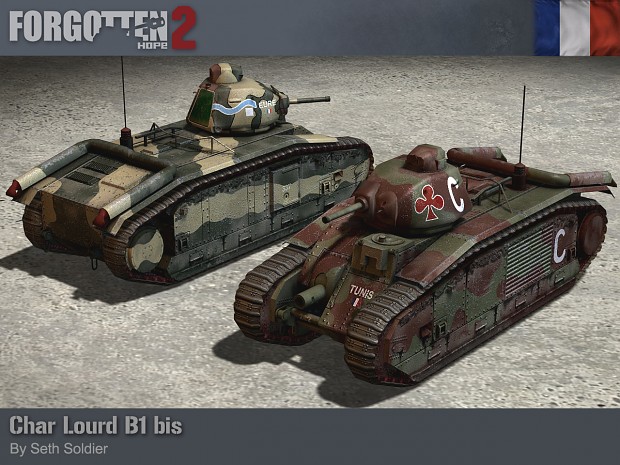Forgotten Hope 2 is an award-winning World War II modification for Battlefield 2TM and is based on the original Forgotten Hope, a modification for Battlefield 1942TM, one of the most popular multiplayer games ever. Battlefield 1942TM featured land, sea and air combat in a way never before seen. It was the goal of the development team to maximize the game experience by adding both a realistic and enjoyable gameplay to FH and now to FH2.
The Char B1 began life in 1919, with a memorandum written by General Estienne that presented concepts for mechanised warfare based on experience from the Great War. One such concept was for a Char de bataille that could fight its way through heavy fortifications in the support of infantry. In 1921 the first request was tendered for such a vehicle: more of a self propelled gun than a tank, with a fixed howitzer and small defensive machinegun turret. Four designs were submitted for trials, and while they all suffered from poor reliability, the second design from Renault and Schneider was chosen as the basis for further work.
The design eventually matured into the B1, armed with a 75mm howitzer in the hull, a low velocity 47mm gun in the APX1 turret with 2 7.5mm reibel machineguns. Armour was 40mm, and there were 4 crew: a driver who also aimed and fired the main gun, a loader, the commander (who stood alone in the turret), and a radio operator. The B1 bis followed very quickly and was the main production variant, with the armour increased to 60mm and the turret swapped for the APX4 with a longer 47mm antitank gun.
To help the driver aim the hull mounted howitzer, the B1 bis used a complicated hydraulic differential steering system. This Naëder system allowed for extremely precise turns but was dependant on one particular type of castor oil and would seize up if the wrong oil was added. The tank was clearly a product of the First World War, and due to its extended development time was entering service effectively obsolete in the face of modern tactics.
The B1 bis was a formidable opponent to the Germans, who's tanks and antitank guns were essentially useless against it at anything further than a stone's throw. However the B1 bis was hampered by their short operational range and by the general inferiority of French doctrine against the German's more manoeuvrable forces. By Seth Soldier.







Char 2C when? :D
The 10 FCM 2C actually produced had not taken part in a battle. They were stuck on their train carriage, the two trains carrying them being bombarded and stuck in a train traffic mess. German troops still managed to save one of them (they were scuttled by their crew) and it was sent to Berlin as a trophee.
French troops in Fh2 ?
Wonderful Seth !